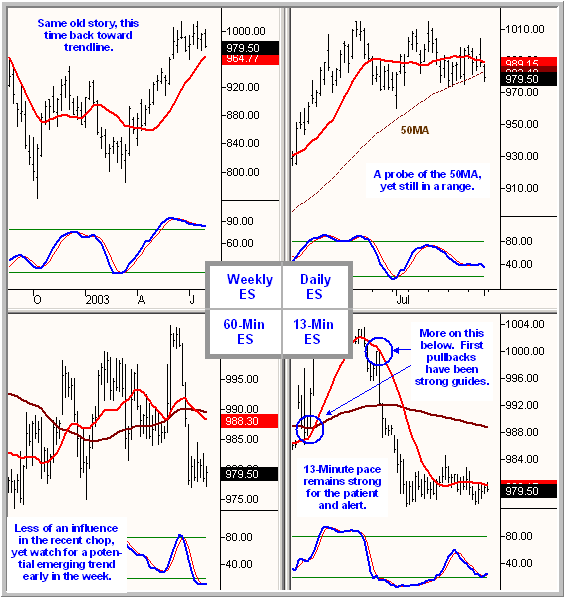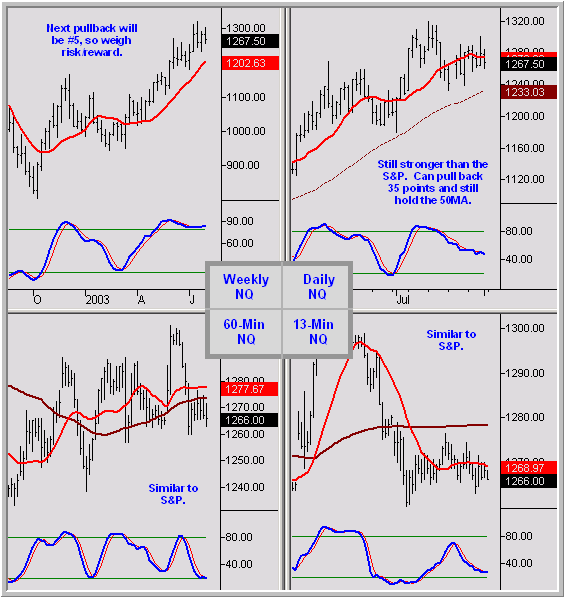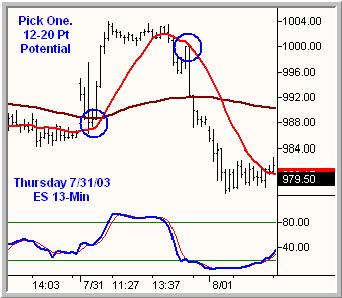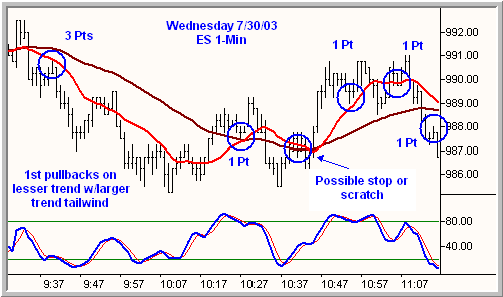Let’s Look At First Pullbacks
Major markets closed this week
near the lower end of recent weekly ranges,
with the S&P and Nasdaq markets closing down 18 and
13 points respectively for the week.Yet amidst the continued longer-term
ping-pong action which may be frustrating swing traders who continue to either
bide their time or trade the current range, the intraday pace continues to
provide varying opportunities for traders of multiple intraday timeframes (more
on that below).
Summer rhythms continue in spades, often reflecting reduced liquidity
exacerbated by news/rumor-driven surges and fast one-way trades — that is, when
traders care enough to peek out from behind their beach umbrellas. Yet as we
eagerly await the typically improved fall trade pace, the market has been
gracious in providing just enough opportunity to fund paychecks for those opting
out of summer vacation.
Let’s first check the charts, and then follow up on last week’s column on recent
rhythms and pullbacks.
S&P 500

Moving Avg Legend:Â
15MAÂ Â Larger
Timeframe 15MA
See https://www.donmillertrading.com
for Setups and Methodologies
Charts © 2003 Tradestation
Nasdaq 100

First Pullbacks
Last week I touched on recent summer market rhythms (torn between rampant
one- and thirteen-minute trends) along with the “first pullback” entry, which is
one of the reversal options on the
E-Mini video and
course
(often coinciding with a 5/15MA cross) and reflects what I believe is among the
best summer time entry options, regardless of timeframe traded. The alternating
one/thirteen rhythm certainly served traders well throughout this past week,
with equal opportunities for both scalpers and 13-minute traders.
Which brings us back to the first pullback entry. Now while I realize a first
pullback option has been around as long as the Yankees have been beating the Red
Sox and isn’t “rocket science” (no pun intended, Mr. Clemens), I thought it
would be appropriate to revisit the basic yet powerful entry given the
alternating summer rhythms we’ve been discussing over recent weeks.
Specifically, I thought we’d look at this past Wednesday and Thursday, which
reflect days that provided strong options for both one-minute scalpers
(Wednesday) and 13-minute traders — on the alternating two days. In fact, as
much as Wednesday’s sardine can range likely aggravated the heck out of
non-scalpers, Thursday’s change in pace was highly refreshing to those less apt
to play the market like pinball flippers.
Let’s first peek at the charts.


Now, while many of you hopefully
must know me by now, I’ll start with the usual disclaimer that my intent is
NOT
to look at these charts with 20/20 hindsight, nor to expect traders to take
every entry. Time of day, ability to fill, slippage, whether a trader is flat or
managing another position, traded timeframe, and trader mindset at the time are
all examples of attributes that would affect one’s ability or desire to trade
such entries. (By the way, ever noticed
that no one in the non-trading “media” ever wants to discuss E-Mini fills? Keep
in mind each bar may only reflect a single contract fill out of hundreds on the
bid or ask … yet I digress so we’ll keep this in mind for future live trading
seminars or columns.)
And I certainly wouldn’t expect 13-minute traders to have stayed in for the
entirety of either Thursday’s bid/ask dropping games, lest we again fall into
the hindsight trap of trading the lower probability of such air pockets.
Yet my point is simply that whether you trade a smaller interval as a scalper or
a larger timeframe, first pullback entries after trend turns remain among the
best options in any market, including this summer’s chopfest. And while a
13-minute trader would have likely sat out much of Wednesday and similar days
while the scalper made his/her daily take, the former had his/her opportunity to
position for similar opportunities on Thursday for a weekly paycheck on one or
two trades — assuming he/she avoided the chop when the trade signals were
non-existent.
Good Trading and Have a
Great Weekend!
